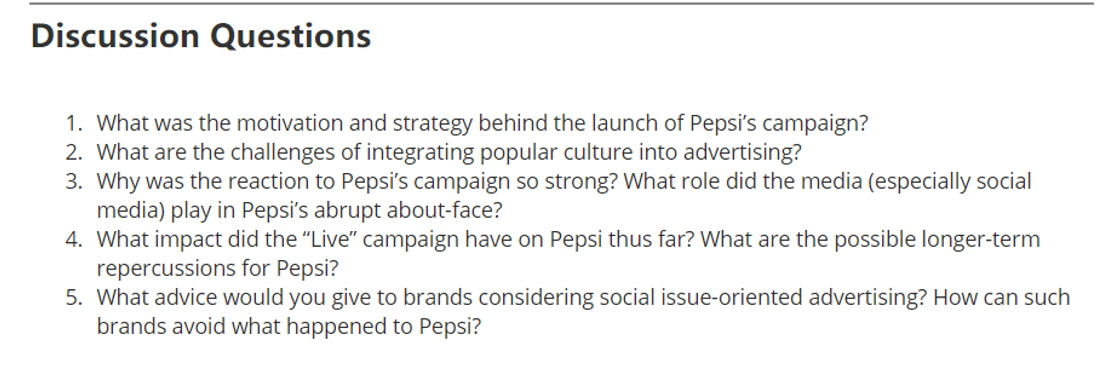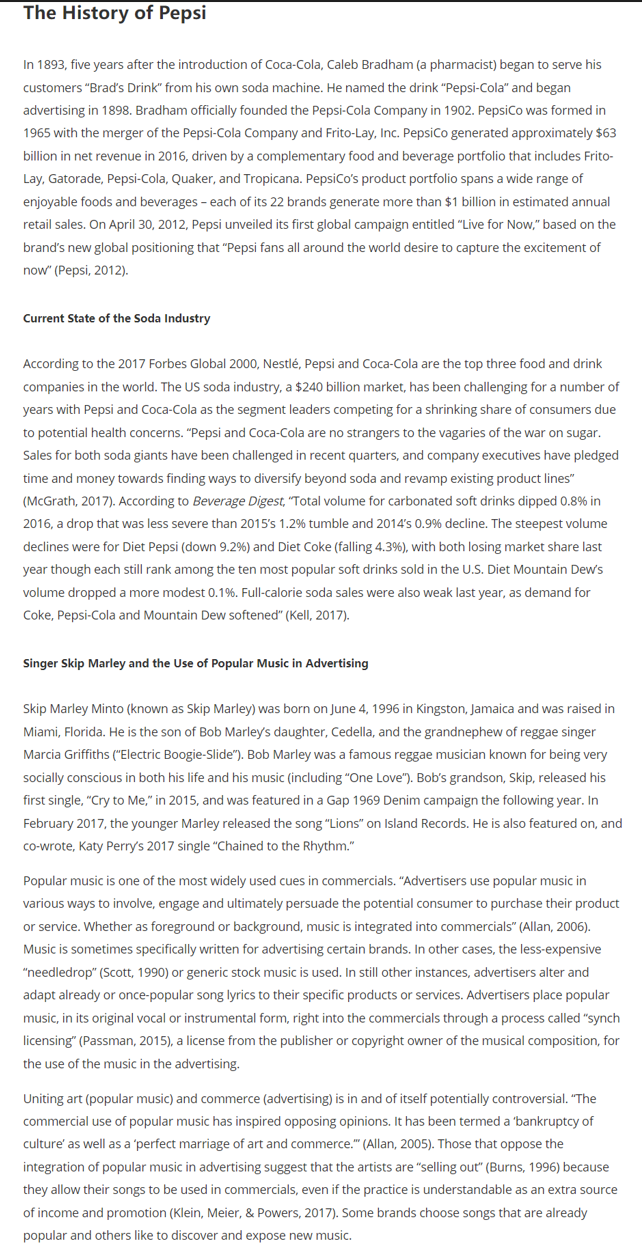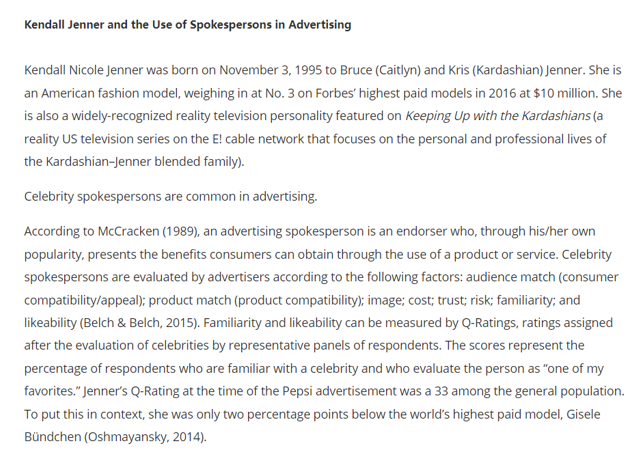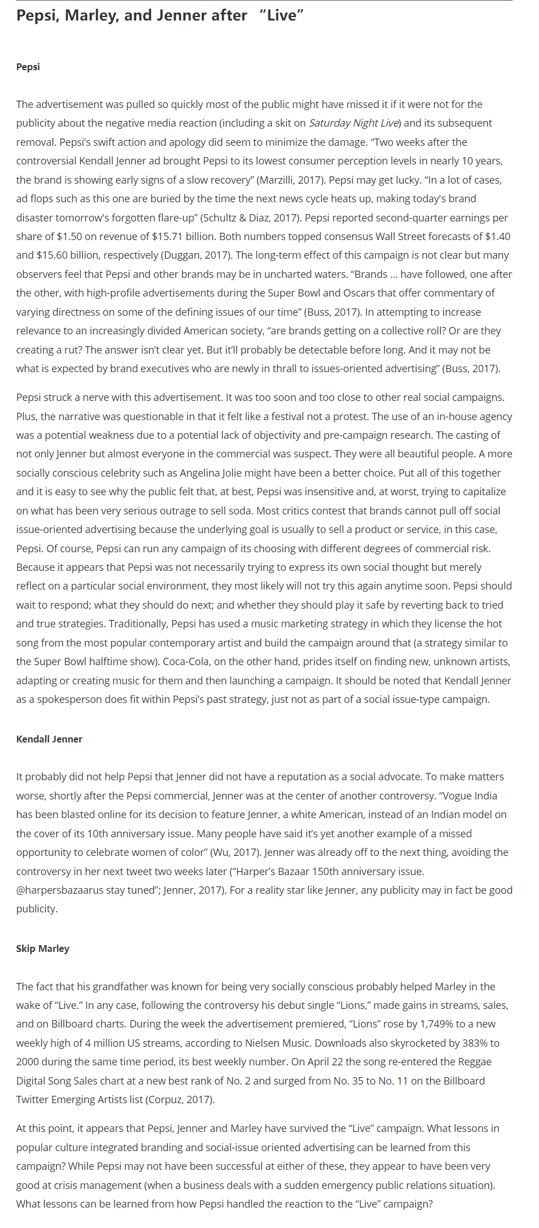Home /
Expert Answers /
Operations Management /
the-history-of-pepsi-in-1893-five-years-after-the-intro-pa622
(Solved): The History of Pepsi In 1893, five years after the intro ...

The History of Pepsi In 1893, five years after the introduction of Coca-Cola, Caleb Bradham (a pharmacist) began to serve his customers "Brad's Drink" from his own soda machine. He named the drink "Pepsi-Cola" and began advertising in 1898. Bradham officially founded the Pepsi-Cola Company in 1902. PepsiCo was formed in 1965 with the merger of the Pepsi-Cola Company and Frito-Lay, Inc. PepsiCo generated approximately \( \$ 63 \) billion in net revenue in 2016, driven by a complementary food and beverage portfolio that includes FritoLay, Gatorade, Pepsi-Cola, Quaker, and Tropicana. PepsiCo's product portfolio spans a wide range of enjoyable foods and beverages - each of its 22 brands generate more than \( \$ 1 \) billion in estimated annual retail sales. On April 30, 2012, Pepsi unveiled its first global campaign entitled "Live for Now," based on the brand's new global positioning that "Pepsi fans all around the world desire to capture the excitement of now" (Pepsi, 2012). Current State of the Soda Industry According to the 2017 Forbes Global 2000, Nestlé, Pepsi and Coca-Cola are the top three food and drink companies in the world. The US soda industry, a \( \$ 240 \) billion market, has been challenging for a number of years with Pepsi and Coca-Cola as the segment leaders competing for a shrinking share of consumers due to potential health concerns. "Pepsi and Coca-Cola are no strangers to the vagaries of the war on sugar. Sales for both soda giants have been challenged in recent quarters, and company executives have pledged time and money towards finding ways to diversify beyond soda and revamp existing product lines" (McGrath, 2017). According to Beverage Digest, "Total volume for carbonated soft drinks dipped \( 0.8 \% \) in 2016, a drop that was less severe than 2015's 1.2\% tumble and 2014's \( 0.9 \% \) decline. The steepest volume declines were for Diet Pepsi (down 9.2\%) and Diet Coke (falling 4.3\%), with both losing market share last year though each still rank among the ten most popular soft drinks sold in the U.S. Diet Mountain Dew's volume dropped a more modest \( 0.1 \% \). Full-calorie soda sales were also weak last year, as demand for Coke, Pepsi-Cola and Mountain Dew softened" (Kell, 2017). Singer Skip Marley and the Use of Popular Music in Advertising Skip Marley Minto (known as Skip Marley) was born on June 4, 1996 in Kingston, Jamaica and was raised in Miami, Florida. He is the son of Bob Marleys daughter, Cedella, and the grandnephew of reggae singer Marcia Griffiths ("Electric Boogie-Slide"). Bob Marley was a famous reggae musician known for being very socially conscious in both his life and his music (including "One Love"). Bob's grandson, Skip, released his first single, "Cry to Me," in 2015, and was featured in a Gap 1969 Denim campaign the following year. In February 2017, the younger Marley released the song "Lions" on Island Records. He is also featured on, and co-wrote, Katy Perrys 2017 single "Chained to the Rhythm." Popular music is one of the most widely used cues in commercials. "Advertisers use popular music in various ways to involve, engage and ultimately persuade the potential consumer to purchase their product or service. Whether as foreground or background, music is integrated into commercials" (Allan, 2006). Music is sometimes specifically written for advertising certain brands. In other cases, the less-expensive "needledrop" (Scott, 1990) or generic stock music is used. In still other instances, advertisers alter and adapt already or once-popular song lyrics to their specific products or services. Advertisers place popular music, in its original vocal or instrumental form, right into the commercials through a process called "synch licensing" (Passman, 2015), a license from the publisher or copyright owner of the musical composition, for the use of the music in the advertising. Uniting art (popular music) and commerce (advertising) is in and of itself potentially controversial. "The commercial use of popular music has inspired opposing opinions. It has been termed a 'bankruptcy of culture' as well as a 'perfect marriage of art and commerce."' (Allan, 2005). Those that oppose the integration of popular music in advertising suggest that the artists are "selling out" (Burns, 1996) because they allow their songs to be used in commercials, even if the practice is understandable as an extra source of income and promotion (Klein, Meier, \& Powers, 2017). Some brands choose songs that are already popular and others like to discover and expose new music.
Kendall Jenner and the Use of Spokespersons in Advertising Kendall Nicole Jenner was born on November 3, 1995 to Bruce (Caitlyn) and Kris (Kardashian) Jenner. She is an American fashion model, weighing in at No. 3 on Forbes' highest paid models in 2016 at \( \$ 10 \) million. She is also a widely-recognized reality television personality featured on Keeping Up with the Kardashians (a reality US television series on the E! cable network that focuses on the personal and professional lives of the Kardashian-Jenner blended family). Celebrity spokespersons are common in advertising. According to McCracken (1989), an advertising spokesperson is an endorser who, through his/her own popularity, presents the benefits consumers can obtain through the use of a product or service. Celebrity spokespersons are evaluated by advertisers according to the following factors: audience match (consumer compatibility/appeal); product match (product compatibility); image; cost; trust; risk; familiarity; and likeability (Belch \& Belch, 2015). Familiarity and likeability can be measured by Q-Ratings, ratings assigned after the evaluation of celebrities by representative panels of respondents. The scores represent the percentage of respondents who are familiar with a celebrity and who evaluate the person as "one of my favorites." Jenner's Q-Rating at the time of the Pepsi advertisement was a 33 among the general population. To put this in context, she was only two percentage points below the world's highest paid model, Gisele Bündchen (Oshmayansky, 2014).
"Live for Now Moments Anthem" Pepsi released its two-and-a-half minute "Live for Now Moments Anthem" advertisement from in-house creative team Creators League Studio on April 4, 2017. With Skip Marley's song "Lions" as the soundtrack, the advertisement features Kendall jenner as a high-fashion model in a blonde wig doing a photo shoot as a large group of protesters passes by. The purpose of the protest is unclear, but one of the protesters encourages Jenner to join. She eventually agrees, removes her blonde wig and hands it to a black woman. Grabbing a can of Pepsi, she heads toward one of the police officers and gives the can to him. He accepts it, smiles, and takes a sip, eliciting cheers from the crowd. The motivation for the campaign is up for debate. One theory is that Pepsi is still trying to have its own "Teach the World to Sing" moment. In 1971, Coca-Cola's "Hilltop" advertisement conceived by Bill Backer originated as a jingle ("Buy the World a Coke"). The jingle, without the references to Coca-Cola, then became a popular song recorded by The Hillside Singers and The New Seekers ("I'd Like to Teach the World to Sing"). The advertisement featured a multicultural/multiracial collection of teenagers on top a hill appearing to sing the song of love, positivity, and togetherness during a time of protest (against the Vietnam War, which occurred between 1955 and 1975). In this case, it appears that Pepsi is adopting a similar strategy by substituting black anti-police-violence protesters into the formula with signs of "love" and "join the conversation." The advertisement was not well received. Time magazine wrote: "This ad's fastand-loose approach to protest imagery - going beyond the vague hippie costuming of the old Coke ad to turn real moments of high tension into an opportunity to celebrate commerce and fame - sounds a discordant note" (D'Addario, 2017). The Black Lives Matter Movement, which involves campaigns against violence and racism toward black people, is a more complicated and sensitive issue than the Vietnam War due to its domestic and racial nature. The Movement regularly holds protests against police killings of black people and broader issues of racial profiling, police brutality, and racial inequality. Another theory is that Pepsi may have intended to join other brands who are trying to be more socially conscious, such as Budweiser and its beer advertisement from Super Bowl Ll. The advertisement's retelling of the story of German immigrant and brewery founder Adolphus Busch is intended to communicate that buying a Bud is associated with supporting America's status as a nation of immigrants. "A recent wave of high-profile ads have used easily-understood, vaguely political messaging to transmit the idea that to buy a given product won't just make you happier - it'll make you more virtuous" (D'Addario 2017). This is nothing new. "This trend began years ago as brand managers felt compelled to promote a 'purpose' beyond merely providing goods and services for customers, paying and rewarding employees, and posting profits and generating returns for investors" (Buss, 2017). To make matters worse, shortly after the Pepsi debacle, Heineken debuted a commercial that was critically and socially applauded. The Heineken advertisement, "Worlds Apart," pairs people with opposing views on hot-button social issues. The pairs, who initially are not aware of each other's views, go through a bonding activity before revealing their opinions. Then they are given a choice to talk about their viewpoints over Heineken or leave. All of them shown choose to stay and talk. Heineken's advertisement got "to the heart of political engagement in a straightforward way that makes Pepsi's self-congratulatory ad seem even more embarrassing" (Berkowitz, 2017). In August 2017 Procter \& Gamble (P\&G) released an online campaign destined for television called "The Talk" showing black mothers sharing "their" truths about bias and racial stereotypes growing up in America. P\&G said they will producer similar advertisements focused on other issues such as gender equality (Morgan, 2017). Whether or not Pepsi was trying to replicate the past or reflect the present, the media response to the advertisement was immediate. Most media focused on Pepsi's insensitivity. "Reception has not been warm, to say the least, as many see a major corporation co-opting a political movement against the current administration, and co-opting Black Lives Matter, to sell soda. There's been an avalanche of negative reactions to the ad, and the backlash only seems to be growing online" (Monllos, 2017). Pepsi initially supported the advertisement, telling Adweek, "This is a global ad that reflects people from different walks of life coming together in a spirit of harmony, and we think that's an important message to convey" (Monllos, 2017). Pepsi pulled the advertisement the following day. "Pepsi was trying to project a global message of unity, peace and understanding. Clearly we missed the mark, and we apologize," the brand said in a statement. "We did not intend to make light of any serious issue. We are removing the content and halting any further rollout. We also apologize for putting Kendall Jenner in this position" (Schultz \& Diaz, 2017).
Pepsi, Marley, and Jenner after "Live" Pepsi The advertisement was pulled so quickly most of the public might have missed it if it were not for the publicity about the negative media reaction (including a skit on Saturday Night Live) and its subsequent removal. Pepsi's swift action and apology did seem to minimize the damage. "Two weeks after the controversial Kendall Jenner ad brought Pepsi to its lowest consumer perception levels in nearly 10 years, the brand is showing early signs of a slow recovery" (Marzilli, 2017). Pepsi may get lucky. "In a lot of cases, ad flops such as this one are buried by the time the next news cycle heats up, making today's brand disaster tomorrow's forgotten flare-up" (Schultz \& Diaz, 2017). Pepsi reported second-quarter earnings per share of \( \$ 1.50 \) on revenue of \( \$ 15.71 \) billion. Both numbers topped consensus Wall Street forecasts of \( \$ 1.40 \) and \( \$ 15.60 \) billion, respectively (Duggan, 2017). The long-term effect of this campaign is not clear but many observers feel that Pepsi and other brands may be in uncharted waters. "Brands ... have followed, one after the other, with high-profile advertisements during the Super Bowl and Oscars that offer commentary of varying directness on some of the defining issues of our time" (Buss, 2017). In attempting to increase relevance to an increasingly divided American society, "are brands getting on a collective roll? Or are they creating a rut? The answer isn't clear yet. But it'll probably be detectable before long. And it may not be what is expected by brand executives who are newly in thrall to issues-oriented advertising" (Buss, 2017). Pepsi struck a nerve with this advertisement. It was too soon and too close to other real social campaigns. Plus, the narrative was questionable in that it felt like a festival not a protest. The use of an in-house agency was a potential weakness due to a potential lack of objectivity and pre-campaign research. The casting of not only Jenner but almost everyone in the commercial was suspect. They were all beautiful people. A more socially conscious celebrity such as Angelina Jolie might have been a better choice. Put all of this together and it is easy to see why the public felt that, at best, Pepsi was insensitive and, at worst, trying to capitalize on what has been very serious outrage to sell soda. Most critics contest that brands cannot pull off social issue-oriented advertising because the underlying goal is usually to sell a product or service, in this case, Pepsi. Of course, Pepsi can run any campaign of its choosing with different degrees of commercial risk. Because it appears that Pepsi was not necessarily trying to express its own social thought but merely reflect on a particular social environment, they most likely will not try this again anytime soon. Pepsi should wait to respond; what they should do next; and whether they should play it safe by reverting back to tried and true strategies. Traditionally. Pepsi has used a music marketing strategy in which they license the hot song from the most popular contemporary artist and build the campaign around that (a strategy similar to the Super Bowl halftime show). Coca-Cola, on the other hand, prides itself on finding new, unknown artists, adapting or creating music for them and then launching a campaign. It should be noted that Kendall Jenner as a spokesperson does fit within Pepsi's past strategy. just not as part of a social issue-type campaign. Kendall Jenner It probably did not help Pepsi that jenner did not have a reputation as a social advocate. To make matters worse, shortly after the Pepsi commercial, Jenner was at the center of another controversy. "Vogue India has been blasted online for its decision to feature jenner, a white American, instead of an Indian model on the cover of its 10th anniversary issue. Many people have said it's yet another example of a missed opportunity to celebrate women of color" (Wu, 2017). Jenner was already off to the next thing, avoiding the controversy in her next tweet two weeks later ("Harper's Bazaar 150 th anniversary issue. @harpersbazaarus stay tuned": Jenner, 2017). For a reality star like Jenner, any publicity may in fact be good publicity. Skip Marley The fact that his grandfather was known for being very socially conscious probably helped Marley in the wake of "Live." In any case, following the controversy his debut single "Lions," made gains in streams, sales, and on Billboard charts. During the week the advertisement premiered, "Lions" rose by 1,749\% to a new weekly high of 4 million US streams, according to Nielsen Music. Downloads also skyrocketed by \( 383 \% \) to 2000 during the same time period, its best weekly number. On April 22 the song re-entered the Reggae Digital Song Sales chart at a new best rank of No. 2 and surged from No. 35 to No. 11 on the Billboard Twitter Emerging Artists list (Corpuz, 2017). At this point, it appears that Pepsi, Jenner and Marley have survived the "Live" campaign. What lessons in popular culture integrated branding and social-issue oriented advertising can be learned from this campaign? While Pepsi may not have been successful at either of these, they appear to have been very good at crisis management (when a business deals with a sudden emergency public relations situation). What lessons can be learned from how Pepsi handled the reaction to the "Live" campaign?
Discussion Questions 1. What was the motivation and strategy behind the launch of Pepsi's campaign? 2. What are the challenges of integrating popular culture into advertising? 3. Why was the reaction to Pepsi's campaign so strong? What role did the media (especially social media) play in Pepsi's abrupt about-face? 4. What impact did the "Live" campaign have on Pepsi thus far? What are the possible longer-term repercussions for Pepsi? 5. What advice would you give to brands considering social issue-oriented advertising? How can such brands avoid what happened to Pepsi?
Expert Answer
1. What was the motivation and strategy behind the launch of Pepsi's campaign? I believe that the motivation and strategy behind launching Pepsi's cam



